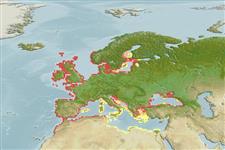>
Syngnathiformes (Pipefishes and seahorses) >
Syngnathidae (Pipefishes and seahorses) > Nerophinae
Etymology: Nerophis: Greek, neros, nearos = youhtfull appearance + Greek,ophis = serpent (Ref. 45335).
More on author: Linnaeus.
Environment: milieu / climate zone / Mức độ sâu / distribution range
Sinh thái học
Biển; Nước ngọt; Thuộc về nước lợ gần đáy; Mức độ sâu 2 - 15 m (Ref. 6733). Temperate; 63°N - 30°N, 11°W - 42°E
Eastern Atlantic: Norway to Morocco (excluding region from Denmark to Netherlands), also throughout the Mediterranean and the Black Sea.
Bộ gần gũi / Khối lượng (Trọng lượng) / Age
Chín muồi sinh dục: Lm ? range ? - ? cm
Max length : 29.0 cm TL con đực/không giới tính; (Ref. 2058); 30.0 cm TL (female)
Anal, caudal and pectoral fins absent (Ref. 59043). Anal opening below front end of the dorsal fin, 28-33 body rings. Has a strait snout (Ref. 35388).
Body shape (shape guide): eel-like.
Inhabit algal zone or eel-grass (Zostera) (Ref. 6733). Adults spawn in May - August . Feed on small crustaceans and fish fry (Ref. 35388). Ovoviviparous (Ref. 205). The male carries the eggs in a brood pouch which is found under the tail (Ref. 205). Consistent paternity is ensured despite brooding of embryos on the outside the male's body. Events of cuckoldry by sneaker males is ruled out through genetic paternity analyses based on molecular markers (Ref. 81011). Each male carries eggs from a single female but females may deposit eggs on several brooding pouches (Ref. 81011).
Life cycle and mating behavior
Chín muồi sinh dục | Sự tái sinh sản | Đẻ trứng | Các trứng | Sự sinh sản | Ấu trùng
Consistent paternity is ensured despite brooding of embryos on the outside of the male's body instead of a brood pouch characteristic of the family (Ref. 81011, 53335). Events of cuckoldry by sneaker males is ruled out through genetic paternity analyses based on molecular markers (Ref. 81011). Each male carries eggs from a single female but females may deposit eggs on several brooding pouches (Ref. 81011).
Dawson, C.E., 1986. Syngnathidae. p. 628-639. In P.J.P. Whitehead, M.-L. Bauchot, J.-C. Hureau, J. Nielsen and E. Tortonese (eds.) Fishes of the North-eastern Atlantic and the Mediterranean. Volume 2. Unesco, Paris. (Ref. 6733)
IUCN Red List Status (Ref. 130435: Version 2025-1)
Threat to humans
Harmless
Human uses
Các nghề cá: không ích lợi (thú vị)
Các công cụ
Special reports
Download XML
Các nguồn internet
Estimates based on models
Preferred temperature (Tài liệu tham khảo
123201): 8.6 - 19.3, mean 13.5 °C (based on 981 cells).
Phylogenetic diversity index (Tài liệu tham khảo
82804): PD
50 = 0.6250 [Uniqueness, from 0.5 = low to 2.0 = high].
Bayesian length-weight: a=0.00093 (0.00036 - 0.00242), b=3.05 (2.83 - 3.27), in cm total length, based on LWR estimates for this (Sub)family-body shape (Ref.
93245).
Mức dinh dưỡng (Tài liệu tham khảo
69278): 3.5 ±0.47 se; based on food items.
Generation time: 1.0 ( na - na) years. Estimated as median ln(3)/K based on 1
growth studies.
Thích nghi nhanh (Tài liệu tham khảo
120179): Chiêù cao, thời gian nhân đôi của chủng quần tối thiểu là dưới 15 tháng (K=1.05).
Fishing Vulnerability (Ref.
59153): Low vulnerability (17 of 100).
🛈
Nutrients (Ref.
124155): Calcium = 52.9 [11.4, 164.9] mg/100g; Iron = 0.518 [0.203, 1.620] mg/100g; Protein = 3.53 [0.00, 7.33] %; Omega3 = 0.457 [0.196, 1.168] g/100g; Selenium = 7.88 [1.15, 24.21] μg/100g; VitaminA = 8.87 [2.82, 27.81] μg/100g; Zinc = 0.772 [0.368, 1.485] mg/100g (wet weight);
